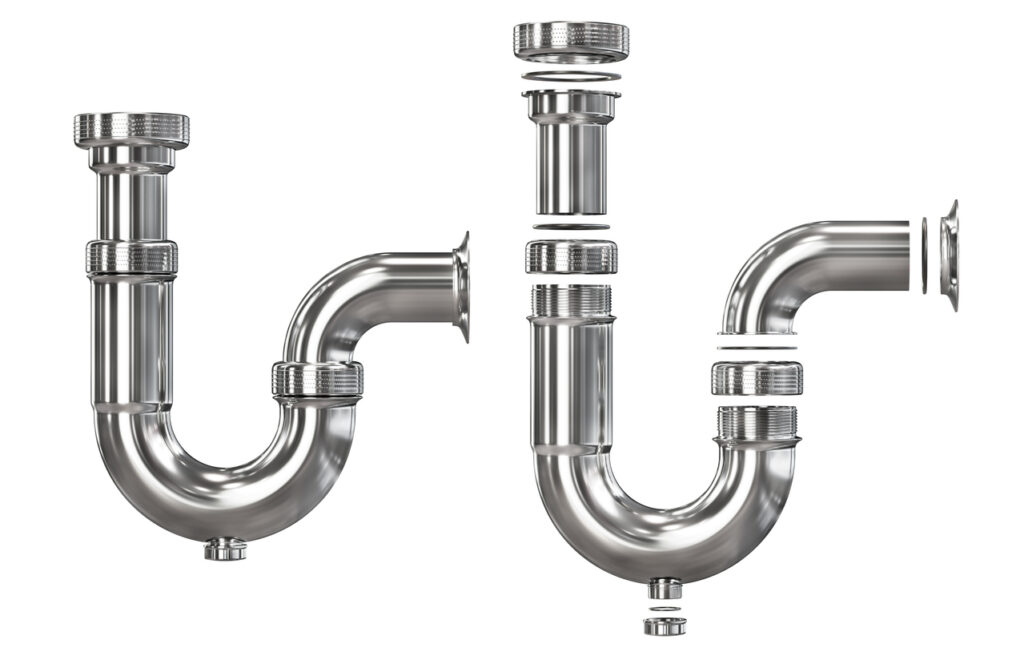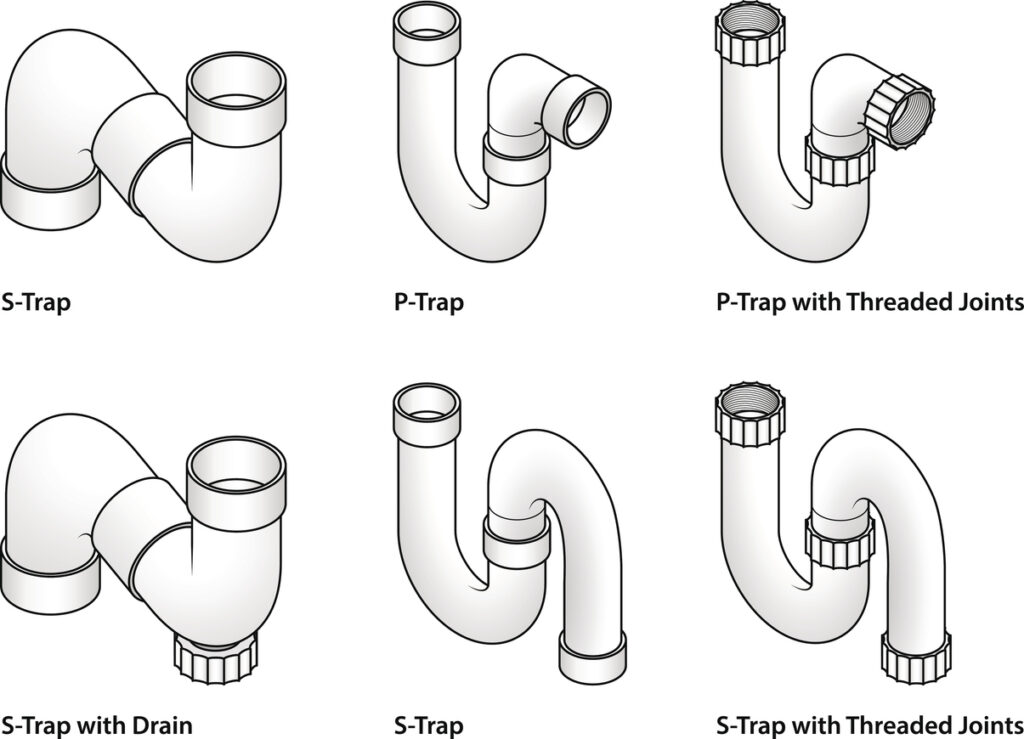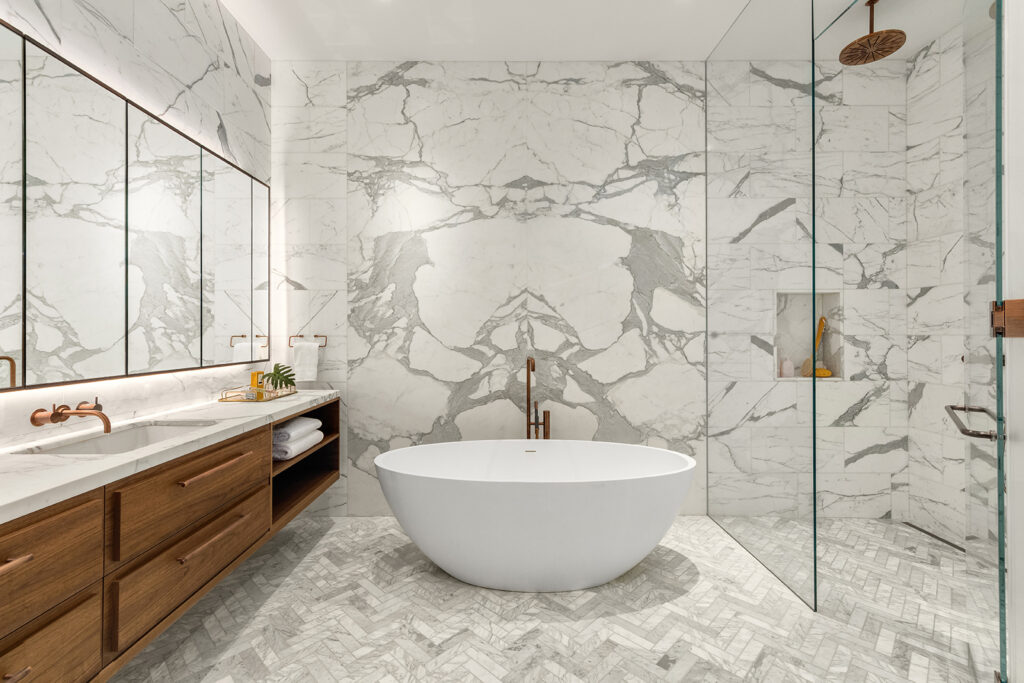
One-Piece vs Two Piece Toilet – Pros and Cons- 2025 Expert Guide
When upgrading your bathroom, one of the most important—and often overlooked—decisions is choosing between a one-piece or two-piece toilet. While
Plumbing traps may seem like small components, but they are critical in keeping your home safe and odor-free. Two of the most common types—S-traps and P-traps—serve the same basic purpose: to create a water seal that blocks sewer gases from entering your living space. However, they differ in design, code compliance, and function. In this guide, we’ll compare S-traps and P-traps in depth to help you understand which is best for your project.

| Feature | S-Trap | P-Trap |
| Shape | Resembles an “S” from the side | Resembles a “P” on its side |
| Drain Orientation | Connects to the floor drain | Connects to the wall drain |
| Ventilation | Poor—prone to siphoning | Better—often vented to prevent siphoning |
| Code Compliance | Often not up to modern plumbing code | Meets current residential codes |
| Water Seal Stability | Frequently dries out | More stable with proper venting |
| Installation Areas | Older homes, rural setups, temporary installs | Modern homes, code-compliant installations |
Now, let’s take a closer look at each of these differences to see how they affect performance, code compliance, and everyday use.
Before discussing each trap type in detail, it’s essential to understand the core differences that distinguish them. While both S-traps and P-traps serve the same essential function—blocking sewer gases from entering your home—they differ in installation method, venting capability, code compliance, and long-term reliability. These differences can directly impact plumbing safety, performance, and legality in your region. Below, we summarize the six most important factors that distinguish the two trap styles.

S-traps have a vertical design that resembles the letter “S” when viewed from the side, while P-traps have a horizontal design that looks like a sideways “P.” The shape directly affects how the trap connects to the drainage system. S-traps drop into the floor, whereas P-traps bend toward a wall drain.
S-traps connect to floor drains, making them suitable for fixtures without nearby wall plumbing. P-traps connect horizontally to a wall drain pipe, which allows for easier venting and better long-term performance. This distinction is crucial for understanding where and how each trap can be installed.
P-traps are typically vented either through a wall vent pipe or with an air admittance valve (AAV), which helps prevent the siphoning of water from the trap. On the other hand, S-traps often lack proper venting, which can result in suction and the loss of the water seal. This makes S-traps more prone to allowing sewer gases into the home.
P-traps are fully compliant with modern plumbing codes across North America and many other regions. S-traps are often considered outdated or even banned in new construction due to their venting issues. If your home is undergoing renovation, converting S-traps to P-traps is often necessary to pass inspection.
Because P-traps are vented and maintain a consistent water seal, they’re more reliable in the long run. S-traps can dry out more easily, especially in fixtures that aren’t used often, creating health and odor issues. P-traps require less frequent maintenance to remain effective.
S-traps may still be found in older homes, rural buildings, or temporary setups where wall access or venting isn’t feasible. P-traps are standard in virtually all new builds and major remodels. If you can access wall plumbing and proper ventilation, a P-trap is the preferred solution.
Now that we’ve reviewed the main differences, let’s take a closer look at the S-trap—what it is, how it functions, and when (if ever) it makes sense to use one.
S-traps were once a standard in residential plumbing but have become less common in modern installations. While they are still found in older homes or makeshift setups, they’re typically flagged during inspections due to poor venting. However, understanding how S-traps function can help you troubleshoot plumbing problems or plan for a future upgrade.
Understanding what an S-trap is begins with its core features. Each of the characteristics below helps explain why S-traps were once common—and why they’ve fallen out of favor.
Each characteristic of an S-trap contributes to how it functions and where its limitations lie.
Despite their drawbacks, S-traps can still be found in specific situations. Let’s look at when and where using an S-trap might still make sense.
While S-traps are no longer recommended for new plumbing installations, there are still scenarios where they might be used temporarily or out of necessity. Here are typical examples where an S-trap may still appear.
Now that we’ve explored where S-traps are used, it’s time to weigh their benefits and drawbacks more directly. Below are the top pros and cons to consider.
S-traps are easy to install, especially when only a floor drain is available. Because there’s no need to connect to a wall or vent system, the installation can be done with fewer materials and less labor. This simplicity appeals to DIYers or those in rural settings. However, this ease comes at the cost of long-term reliability.
The vertical configuration makes S-traps useful in cramped conditions where a horizontal P-trap won’t fit. This is particularly handy in small utility rooms or under outdoor sinks. Their compact design allows for creative routing in unconventional setups. However, lack of venting still makes them less efficient.
S-traps are inexpensive and widely available at hardware stores, especially in PVC form. This makes them a budget-friendly choice for quick fixes or non-permanent installations. The upfront savings can be attractive for those looking to stretch renovation dollars. Just remember that this low cost may lead to expensive issues down the line.
In situations with no wall drain or vent nearby, the S-trap can be a workaround. It connects directly to the floor plumbing without rerouting infrastructure. This is often the only solution when plumbing needs to be retrofitted in a non-standard location.
If you’re remodeling or waiting for professional installation, an S-trap can serve as a stopgap. It can keep a fixture functional while planning a proper P-trap replacement. For short-term usage, it’s better than leaving an open drain. Just don’t treat it as a permanent solution.
Modern plumbing codes prohibit the use of S-traps due to their siphoning risk. If your system is inspected or permitted, the S-trap will likely need to be replaced. Using one in new construction or major renovations could result in delays or fines. To avoid these issues, it’s best to upgrade to a vented P-trap.
One of the S-trap’s biggest flaws is its tendency to siphon water out after each use. When this happens, the barrier between your home and sewer gases is gone, leading to unpleasant odors and potential health risks. Frequent use or additional venting may reduce, but not eliminate, this issue.
Upgrading an S-trap to a P-trap often requires rerouting the drain pipe from the floor to the wall, adding a vent, and sometimes opening up walls or floors. This can be labor-intensive and costly. While worth it for long-term value and compliance, it’s a significant investment upfront.
S-traps are more likely to dry out when the connected fixture isn’t used regularly. This makes them a poor choice for guest bathrooms or seasonal outdoor sinks. Once the water seal evaporates, sewer gases can leak into the home.
Even with proper use, S-traps aren’t built for modern plumbing standards. Over time, the lack of venting causes performance issues, and replacing them becomes inevitable. Investing in a compliant setup from the start saves time and money.
Still have questions about S-traps? These FAQs cover common concerns about legality, safety, and whether upgrading is worth it.
Q: Are S-traps illegal?
A: While not federally banned, S-traps are prohibited under most modern plumbing codes in the U.S., Canada, and other countries due to their tendency to lose their water seal. This can lead to sewer gases entering living spaces, which is both a health and safety risk. If found in a home inspection, they are often flagged for replacement. Some jurisdictions may allow them with added venting or air admittance valves, but they are rarely approved for new construction.
Q: Can I convert an S-trap to a P-trap?
A: Yes, but it usually requires more than just swapping out parts. You’ll need to reroute the drain line from the floor to the wall and install a vent pipe or an air admittance valve (AAV). While this can be a DIY project for an experienced homeowner, hiring a licensed plumber is highly recommended to ensure code compliance and proper performance.
Q: Is there any situation where an S-trap is acceptable?
A: In rare cases, S-traps may still be allowed for temporary or outdoor fixtures where no wall access is available and venting is impractical. Even then, many local codes require additional measures like an air admittance valve to reduce siphoning. Always check your local plumbing regulations before installing one.
While S-traps have their place in older or temporary setups, modern plumbing relies on a more reliable and code-compliant solution: the P-trap. Let’s explore what makes the P-trap the preferred standard in today’s residential and commercial plumbing systems
P-traps are the modern standard in residential and commercial plumbing. Designed with a horizontal orientation and built-in venting capability, they are both highly effective and fully code-compliant. If you’re doing any type of new construction, renovation, or fixture replacement, a P-trap is the solution you’re most likely to encounter—and for good reason.
In most scenarios, each of the following traits makes the P-trap a superior and more reliable plumbing option.
These features help explain why P-traps are used in so many applications. Here are the most common places you’ll find them in action.
P-traps are the go-to choice for almost any permanent or code-compliant installation. They’re used across residential, commercial, and industrial plumbing systems and are adaptable to various fixtures.
Now that you know where P-traps are used, let’s discuss their biggest advantages and a few limitations.
P-traps meet all major plumbing code requirements across the U.S., Canada, and other developed countries. Whether it’s a renovation, a brand-new build, or a commercial upgrade, you’ll never run into compliance issues with a P-trap. This makes it the safest long-term choice. It also streamlines permitting and inspections.
The horizontal orientation and built-in venting help the P-trap retain its water barrier with every use. This water seal is essential for preventing sewer gases from entering your living space. You won’t have to worry about the trap drying out under normal conditions. It’s ideal for both high-traffic and occasional-use fixtures.
Whether connected to a traditional vent stack or an air admittance valve (AAV), P-traps function optimally in properly vented systems. This makes them compatible with both conventional and modern plumbing setups. It also enhances performance and reduces the likelihood of gurgling or slow drainage.
Most P-traps have slip joints that allow for quick disassembly and cleaning. This is especially useful in kitchens or laundry rooms, where clogs are more common. Replacement parts are inexpensive and widely available. Even novice DIYers can service or replace a P-trap without hiring a plumber.
P-traps are available in multiple materials and sizes, making them adaptable to a wide range of fixture types and installation needs. Whether you’re working in a tight cabinet or an exposed area, there’s a P-trap that will work. They’re also more aesthetically pleasing when using designer finishes like chrome or brass.
Because P-traps connect to wall drains, they’re not a good fit for floors-only plumbing systems unless modifications are made. This can be a challenge in older homes or garages without wall access. Retrofitting for wall plumbing adds time and cost to the project. It’s not ideal for quick or temporary fixes.
If your drain exits through the floor—like in many older homes or outdoor buildings—you can’t simply install a P-trap without rerouting the pipe. You’ll need to convert the system or use an AAV with special venting considerations. This limits the flexibility of the P-trap in legacy plumbing environments.
Compared to the plug-and-play simplicity of an S-trap, installing a P-trap requires more precise alignment and potentially venting connections. If the wall pipe isn’t perfectly positioned, you might need extension kits or angled fittings. It’s not overly difficult, but it’s a step up from basic installs.
Although P-traps are easy to clean, they can still collect hair, grease, or soap scum over time. If left unchecked, this can lead to slow drainage or backups. Regular cleaning or installing a drain screen can prevent buildup. Fortunately, access for cleaning is very straightforward.
If you’re switching from an S-trap to a P-trap in a space without existing wall plumbing, you’ll likely need a plumber. Converting the drain line and adding a vent pipe isn’t always DIY-friendly. This can add to the cost of otherwise simple remodels. However, it’s worth the investment for long-term compliance.
Do you have more questions about installing, maintaining, or identifying a P-trap? The FAQ section below covers everything you need to know before proceeding.
Q: Is a P-trap required by building code?
A: Yes. P-traps are the industry standard and are required by virtually all local and national plumbing codes. They offer safe, effective, and vented drainage solutions and are preferred by both inspectors and contractors. If you’re planning a remodel, installing a P-trap will ensure your project passes inspection.
Q: How do I know if my trap is a P-trap?
A: Look for a U-shaped bend that curves horizontally toward the wall. The connection should lead to a vent or air admittance valve. P-traps are typically located under sinks, showers, or bathtubs. If your drain connects into the wall rather than the floor, you likely have a P-trap.
Choosing between an S-trap and a P-trap comes down to safety, code compliance, and long-term performance. While S-traps may serve temporary or legacy purposes, P-traps are the modern, reliable solution for most residential and commercial plumbing needs.

Eric is the founder and president of Badeloft USA. He has been the president of Badeloft’s US division for over ten years and oversees all marketing and branding aspects of Badeloftusa.com.
His expertise lies in small business development, sales, and home and bathroom industry trends and information.
Contact us with any business related inquiries.

Free material samples and tub templates

When upgrading your bathroom, one of the most important—and often overlooked—decisions is choosing between a one-piece or two-piece toilet. While

Small details, including what you place on the floor, can make a big difference when setting up or upgrading your

Plumbing traps may seem like small components, but they are critical in keeping your home safe and odor-free. Two of
When shopping for new bath linens, the difference between a bath towel and a bath sheet can feel subtle, but
Request your free material sample below. By submitting, you agree to receive occasional product updates and offers from Badeloft. Unsubscribe anytime.
"*" indicates required fields
"*" indicates required fields
"*" indicates required fields